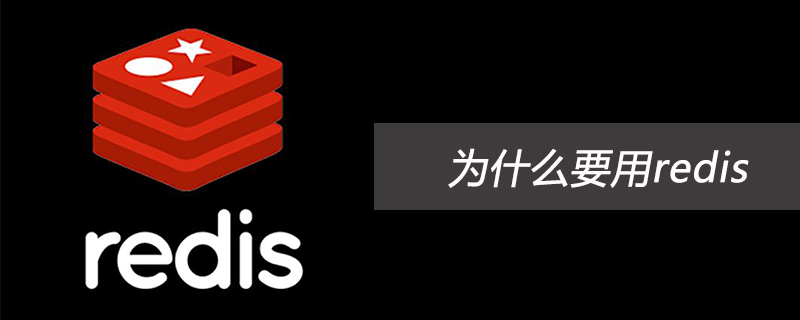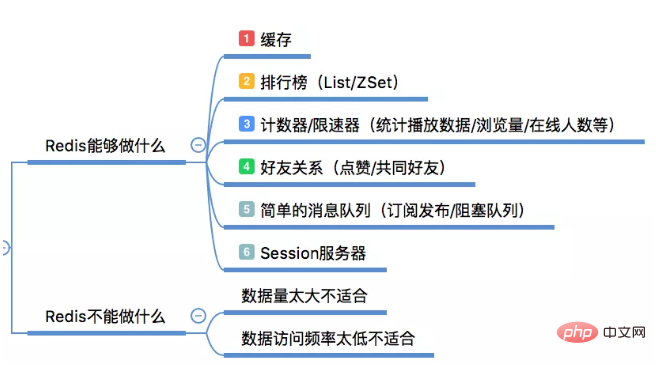Why use redis?

Redis can do anything
Caching, there is no doubt that this is the most well-known use of Redis today Scenes. It is very effective in improving server performance;
Ranking list. If you use a traditional relational database to do this, it will be very troublesome, but using the SortSet data structure of Redis can be very convenient;
Calculator/speed limiter, using the atomic auto-increment operation in Redis, we can count the number of user likes, user visits, etc. If MySQL is used for this type of operation, frequent reading and writing will bring considerable inconvenience. Pressure; A typical usage scenario of the speed limiter is to limit the frequency of a user's access to a certain API. Commonly used ones include rush buying to prevent users from unnecessary pressure caused by crazy clicking;
Friend relationships, using collections Some commands, such as intersection, union, difference, etc. It can easily handle functions such as mutual friends and common hobbies;
Simple message queue, in addition to Redis's own publish/subscribe mode, we can also use List to implement a queue mechanism, such as: arrival notification, Requirements such as email sending do not require high reliability, but will bring a lot of DB pressure. List can be used to complete asynchronous decoupling;
Session sharing, taking PHP as an example, the default Session is saved In the server file, if it is a cluster service, the same user may land on different machines, which will cause users to log in frequently; after using Redis to save the Session, the user can obtain the corresponding information no matter which machine he lands on. Session information.
What can't Redis do
Redis seems to be able to do a lot of things, but it is not a panacea. Use it in the right place to get twice the result with half the effort. If abused, it may lead to system instability, increased costs and other problems.
For example, Redis is used to save basic user information. Although it can support persistence, its persistence solution cannot guarantee the absolute landing of data, and may also cause Redis performance to decrease because of persistence. Too frequently will increase the pressure on the Redis service.
A simple summary is that businesses with too large amounts of data and very low data access frequency are not suitable for using Redis. If the data is too large, it will increase costs, and the access frequency is too low. Storing it in memory is a waste of resources.

You always need to find a reason for your choice
The above mentioned some usage scenarios of Redis, and there are many solutions to these scenarios. Other options include Memcache for caching, MySql for session sharing, and RabbitMQ for message queue. Why must we use Redis? Fast speed, completely based on memory, implemented in C language, the network layer uses epoll to solve high concurrency problems, and the single-threaded model avoids unnecessary context switching and competition conditions;
Note:Single thread only means using one thread to process the client's request in the network request module. Like persistence, it will reopen a thread/process for processing
Rich data types. Redis has 8 data types. Of course, the five commonly used types are String, Hash, List, Set, and SortSet. They all organize data based on key values. Each data type provides a very rich set of operation commands, which can meet most needs. If you have special needs, you can also create new commands yourself through Lua scripts (with atomicity);
 In addition to the rich data types provided, Redis also provides personalized functions such as slow query analysis, performance testing, Pipeline, transactions, Lua custom commands, Bitmaps, HyperLogLog, publish/subscribe, Geo, etc.
In addition to the rich data types provided, Redis also provides personalized functions such as slow query analysis, performance testing, Pipeline, transactions, Lua custom commands, Bitmaps, HyperLogLog, publish/subscribe, Geo, etc.
The code of Redis is open sourced on GitHub. The code is very simple and elegant, and anyone can understand its source code; its compilation and installation is also very simple, without any system dependencies; there is a very active community, various The client's language support is also very complete. In addition, it also supports transactions (never used), persistence, and master-slave replication, making high availability and distribution possible.
 As a developer, the things we use cannot be made into a black box. We should go deep into it and become more understanding and familiar with it. Today I will briefly talk about the usage scenarios of Redis and why I chose Redis instead of others. Next time, we will summarize the internal data structure of Redis and the time complexity of commonly used commands.
As a developer, the things we use cannot be made into a black box. We should go deep into it and become more understanding and familiar with it. Today I will briefly talk about the usage scenarios of Redis and why I chose Redis instead of others. Next time, we will summarize the internal data structure of Redis and the time complexity of commonly used commands.
For more Redis related knowledge, please visit the
Redis usage tutorialThe above is the detailed content of Why use redis?. For more information, please follow other related articles on the PHP Chinese website!

Hot AI Tools

Undresser.AI Undress
AI-powered app for creating realistic nude photos

AI Clothes Remover
Online AI tool for removing clothes from photos.

Undress AI Tool
Undress images for free

Clothoff.io
AI clothes remover

Video Face Swap
Swap faces in any video effortlessly with our completely free AI face swap tool!

Hot Article

Hot Tools

Notepad++7.3.1
Easy-to-use and free code editor

SublimeText3 Chinese version
Chinese version, very easy to use

Zend Studio 13.0.1
Powerful PHP integrated development environment

Dreamweaver CS6
Visual web development tools

SublimeText3 Mac version
God-level code editing software (SublimeText3)

Hot Topics
 How to build the redis cluster mode
Apr 10, 2025 pm 10:15 PM
How to build the redis cluster mode
Apr 10, 2025 pm 10:15 PM
Redis cluster mode deploys Redis instances to multiple servers through sharding, improving scalability and availability. The construction steps are as follows: Create odd Redis instances with different ports; Create 3 sentinel instances, monitor Redis instances and failover; configure sentinel configuration files, add monitoring Redis instance information and failover settings; configure Redis instance configuration files, enable cluster mode and specify the cluster information file path; create nodes.conf file, containing information of each Redis instance; start the cluster, execute the create command to create a cluster and specify the number of replicas; log in to the cluster to execute the CLUSTER INFO command to verify the cluster status; make
 How to clear redis data
Apr 10, 2025 pm 10:06 PM
How to clear redis data
Apr 10, 2025 pm 10:06 PM
How to clear Redis data: Use the FLUSHALL command to clear all key values. Use the FLUSHDB command to clear the key value of the currently selected database. Use SELECT to switch databases, and then use FLUSHDB to clear multiple databases. Use the DEL command to delete a specific key. Use the redis-cli tool to clear the data.
 How to read redis queue
Apr 10, 2025 pm 10:12 PM
How to read redis queue
Apr 10, 2025 pm 10:12 PM
To read a queue from Redis, you need to get the queue name, read the elements using the LPOP command, and process the empty queue. The specific steps are as follows: Get the queue name: name it with the prefix of "queue:" such as "queue:my-queue". Use the LPOP command: Eject the element from the head of the queue and return its value, such as LPOP queue:my-queue. Processing empty queues: If the queue is empty, LPOP returns nil, and you can check whether the queue exists before reading the element.
 How to use the redis command
Apr 10, 2025 pm 08:45 PM
How to use the redis command
Apr 10, 2025 pm 08:45 PM
Using the Redis directive requires the following steps: Open the Redis client. Enter the command (verb key value). Provides the required parameters (varies from instruction to instruction). Press Enter to execute the command. Redis returns a response indicating the result of the operation (usually OK or -ERR).
 How to use redis lock
Apr 10, 2025 pm 08:39 PM
How to use redis lock
Apr 10, 2025 pm 08:39 PM
Using Redis to lock operations requires obtaining the lock through the SETNX command, and then using the EXPIRE command to set the expiration time. The specific steps are: (1) Use the SETNX command to try to set a key-value pair; (2) Use the EXPIRE command to set the expiration time for the lock; (3) Use the DEL command to delete the lock when the lock is no longer needed.
 How to read the source code of redis
Apr 10, 2025 pm 08:27 PM
How to read the source code of redis
Apr 10, 2025 pm 08:27 PM
The best way to understand Redis source code is to go step by step: get familiar with the basics of Redis. Select a specific module or function as the starting point. Start with the entry point of the module or function and view the code line by line. View the code through the function call chain. Be familiar with the underlying data structures used by Redis. Identify the algorithm used by Redis.
 How to configure Lua script execution time in centos redis
Apr 14, 2025 pm 02:12 PM
How to configure Lua script execution time in centos redis
Apr 14, 2025 pm 02:12 PM
On CentOS systems, you can limit the execution time of Lua scripts by modifying Redis configuration files or using Redis commands to prevent malicious scripts from consuming too much resources. Method 1: Modify the Redis configuration file and locate the Redis configuration file: The Redis configuration file is usually located in /etc/redis/redis.conf. Edit configuration file: Open the configuration file using a text editor (such as vi or nano): sudovi/etc/redis/redis.conf Set the Lua script execution time limit: Add or modify the following lines in the configuration file to set the maximum execution time of the Lua script (unit: milliseconds)
 How to use the redis command line
Apr 10, 2025 pm 10:18 PM
How to use the redis command line
Apr 10, 2025 pm 10:18 PM
Use the Redis command line tool (redis-cli) to manage and operate Redis through the following steps: Connect to the server, specify the address and port. Send commands to the server using the command name and parameters. Use the HELP command to view help information for a specific command. Use the QUIT command to exit the command line tool.






